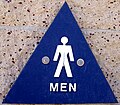Gender symbol
A gender symbol denotes the gender of an organism.
Standard symbols
The two standard sex symbols denoting male ♂ and female ♀ are derived from astrological symbols, denoting the classical planets Mars and Venus, respectively. These symbols have been in use since the Renaissance[1] also denoting elements in alchemy, specifically the metals iron and copper.
They were first used to denote the effective sex of plants (i.e. sex of individual in a given crossbreed, since most plants are hermaphroditic) by Carl Linnaeus in 1751.[2] They are still used in scientific publications to indicate the sex of an individual, for example of a patient.[3] Pedigree charts published in scientific papers now more commonly use a square for male and a circle for female.[4]
The shape of the Mars symbol has been likened to an iron-tipped spear (i.e. a weapon mainly used by men) and shape of the Venus symbol to a bronze mirror or a distaff (stereotypically associated with women in former centuries).[citation needed]

|
Mars symbol (U+2642 ♂). The symbol for a male organism or man. |

|
Venus symbol (U+2640 ♀). The symbol for a female organism or woman. |

|
Square symbol (U+25A1 □). The symbol for a male family member in a pedigree chart.[4] |

|
Circle symbol (U+25CB ○). The symbol for a female family member in a pedigree chart.[4] |
Related LGBT and scientific symbols
This article needs additional citations for verification. (October 2010) |
Numerous variations of gender symbols have been developed in the context of LGBT (lesbian, gay, bisexual and transgender) culture since the 1970s.[5] Some of these symbols have been adopted into Unicode beginning with version 4.1 (2005).

|
From the symbol of Mercury (U+263F ☿). This symbol is used to indicate a virgin female (for example, in genetic analysis). Also used in botany to indicate flower with both male and female reproductive organs. Mercury is one traditional symbol used by intersex people; a usage that derives from Hermaphroditus of Greek mythology.[5] |

|
From the female and male symbols (U+26A5 ⚥). Intersex[citation needed] or transgender.[5] |

|
Another transgender symbol, a combination of the male and female sign with a third, combined arm representing non-binary transgender people (Unicode: U+26A7 ⚧). |
Other gender symbols in Unicode and table 4.1+:

|
⚢ (U+26A2): Double female sign, often used to symbolize lesbianism.[5] |
| ⚣ (U+26A3): Double male sign, used since the 1970s to represent gay men.[5] | |

|
⚤ (U+26A4): Interlocked male and female sign, used since the 1970s to represent gay liberation.[5] Today it might also be used by a heterosexual who is aware of the diversity between men and women |

|
⚦ (U+26A6): Male with stroke sign, used as a symbol for transgender. |

|
⚨ (U+26A8): Vertical male with stroke sign. It means ‘other’ gender. |

|
⚩ (U+26A9): Horizontal male with stroke sign. It also means ‘other’ gender. |

|
⚪ (U+26AA): Medium white circle base, used as a symbol for asexuality, sexless or genderless (neuter). |

|
⚲ (U+26B2): Neuter. This is in fact the shape of the original (medieval) "Venus" symbol (depicting a hand mirror), the additional horizontal bar being of modern date. [citation needed] |
Public restroom pictograms
-
Standard AIGA symbols
-
Non-AIGA women's public restroom symbol
-
Non-AIGA Men's public restroom symbol
See also
- Astrological symbols
- Miscellaneous Symbols Unicode block
Notes
- ^ continuing medieval (11th century) symbols known from Byzantine manuscripts, possibly with precedents in horoscopic papyri of Late Antiquity (late 4th century)[citation needed].
- ^ Stearn, William T. (May 1962). "The Origin of the Male and Female Symbols of Biology". Taxon. 11 (4): 109–113. doi:10.2307/1217734.
- ^ Zhigang, Zhigang; et al. (25 September 2009). "A HIV-1 heterosexual transmission chain in Guangzhou, China: a molecular epidemiological study". Virology Journal. 6 (148). BioMed Central: Figure 1. doi:10.1186/1743-422X-6-148. Retrieved 31 December 2015.
(Mars male gender symbol) indicates male; (female Venus gender symbol) indicates female
{{cite journal}}: CS1 maint: unflagged free DOI (link) - ^ a b c Schott, G D (24 Dec 2005). "Sex symbols ancient and modern: their origins and iconography on the pedigree". BMJ. 331 (7531). British Medical Journal: 1509–1510. doi:10.1136/bmj.331.7531.1509. Retrieved 31 December 2015.
- ^ a b c d e f "Symbolism". LGBTQA+ WebCenter. Eastern Illinois University. Retrieved 31 December 2015.



